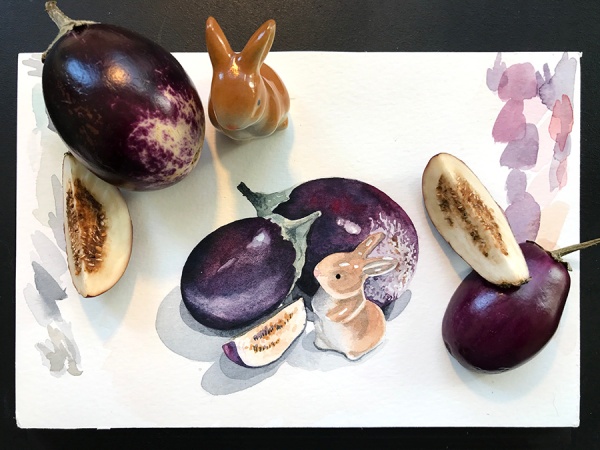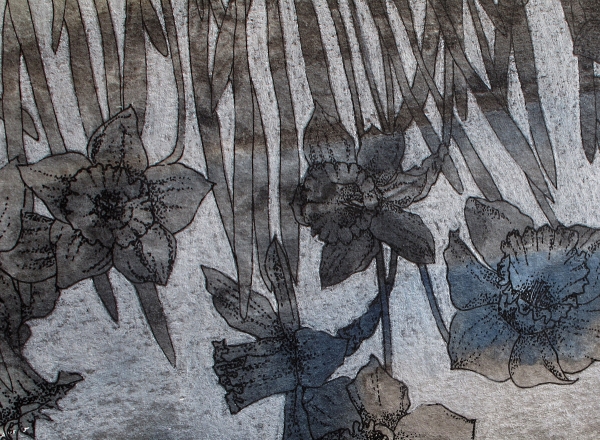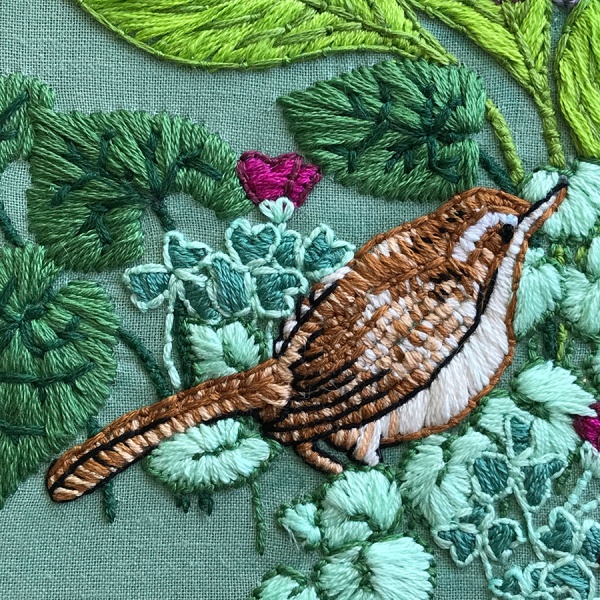What the heck does it mean to define your visual vocabulary and why should you do this as an artist? Visual what now? Vocabulary. Yup – language. Art is communication – all art. Even if you never share it with anyone, you are communicating when you make art.
What are you saying as an artist? What you chose to depict and how you do this matters – this is your visual vocabulary. Your choices open a dialog between you and your work, and your work with an audience; you are a participant even if you are not aware that you are having the conversation.

Knowing what your art communicates is something every artist is (or should be) encouraged to do. Defining your visual vocabulary means looking at the imagery and visual elements you frequently use and outlining why this matters. I did this as a graduate student and, I am not going to front… I freaking hated it. I did not understand why it was important and I felt like I was making shit up to please my professors. When I struggled to come up with something believable – some reason why I did what I did – I felt like I was”faking it”. The feeling of being an imposter was a constant demon in my head.
So… fun times, right? Why in the world would anyone want to voluntarily do this, you might ask? Because there is a method to the madness. There are just a few harmful mindsets that make this process really difficult and ultimately, there is just a wrong and a right way to lead a horse to water because every horse is different.
Yes, in this metaphor the artist is the horse… And that is kinda fair because the process of learning how to be an effective artist is sort of like being broken. All our old habits of thinking are often broken down to make way for better and more effective methods – and it is really painful at times. And, we resist what we know we have to do… ALL the time… but it sucks that this is somehow the art school standard approach and I do not personally believe this is they way things have to be. It might work for some people, but for me, all it did was make me lose myself for a long time – and get bitter.
Fortunately, I am slowly starting to recover (8 years and counting) and I find my way back to myself in fits and starts when I least expect it. I think that it has taken some distance to be able to wrap my head around who I am as an artist and why I even want to make art anymore when my life is so dramatically different now than it was when I was in school.
Side note: I’ve been writing this blog for almost a decade. I started doing so when I was in grad school so I could straighten out all this crap. I am obviously still working on it.

So why can’t I just make pretty things? I believe I took this criticism to mean that what I was making was in some way not valid enough to be considered legitimate because it wasn’t something that was visually provocative. This was re-emphasized with critiques that seemed to suggest that my subjects weren’t experimental or avant-guard enough. They weren’t political. They relied too much on historical references and didn’t focus enough on contemporary issues.
Perhaps I simply misunderstood the message – or it was communicated exceptionally poorly? Because now, looking back, I think that the basic message well meaning professors were trying to drive home was that all art says something.
Unfortunately for me at the time, I felt clueless as to how to define this for myself and so a lot of guesswork and pandering pursued. In the end, I just ended up trying to do the opposite of what I was doing with a certain degree of passive sarcasm I have come to rely on when I feel forced to be something I am not. In many ways, this meager act of rebellion was exactly what I needed to begin to shape how symbols and metaphors could be used more effectively in my work – to make something pretty what also communicated something.
Instead of beautiful living birds, I painted beautiful dead birds. Oh past me… so angsty.

Finding a visual voice is different for everyone. Depending on the type of work or media you favor, your own visual vocabulary could be quite different from another artist.
Over the last decade I have come to some good realizations about my work. And more recently, in trying to redefine my current visual and symbolic vocabulary, I have come to see myself and my art differently.
I like to work with symbols and metaphors. I like to make things look pretty. I like to embrace the poetic and beautiful connections I see between my experiences and the way the world works. My vocabulary focuses on symbols. I like to separate my personal experiences from my art in this way so that it becomes something a viewer can project themselves into and relate to in a personal way.

Simple things emerge when I start to break apart the different types of imagery I repeatedly use: Narcissus flowers reference my relationship with my dad, a doily is used to literally and symbolically disguise something that is perceived as lacking in beauty or which is shameful or embarrassing, the colors yellow ochre, earth orange, teal, and pale pink are all various mental states that I find myself in during or upon reflecting on a moment in time. The list (literally) goes on… (I’m at 8 pages at the moment).

I am not some glowing example of how to do things – I’m still working on this vocabulary 2.0 project at the moment and I imagine I’ll be working on it for awhile longer still.
I do know one thing, I learn most from my mistakes. Here are 2 of the biggest mistakes I made along the way to defining my visual vocabulary – mistakes that kept me from even arriving in a place where I could evaluate how I felt about my visual voice.
Mistake 1: I believed that I needed a profound and poetic reason for liking something in order for that interest to be valid and worth my time.
Being in Art School meant that I was surrounded with all types of passionate characters whose ideas about art were as diverse as they were. I like what I like and I do not always know why. In certain art school environments it was easy to feel like a poser if I just loved something without a significant reason. I got told my art was “too pretty” on more than one occasion. Of course, our choices as artists do matter, but the pressure to define or justify our choices as artists can often begin far earlier than is conducive for true personal growth.
I did not understand why it was important that I know why I liked drawing birds before I started feeling obligated to present the why of it with some kind of authentic self-awareness. This led to negative feelings of non-conformity when I failed to hit the right marks. In my mind I was somehow just pretending to be an artist and everyone around me would find out eventually.
What I Learned: You can like whatever the hell you like and you do not have to know why until you do.
Through the act of making, we as artists, are explorers. What we each explore through this process is different but – in the end – we all discover small truths that eventually lead to bigger ones. We all come to an understanding of why something is important to us as we create regardless of how figured out we think we have things when we begin.
In school it is easy for the pressure to end up in skipped steps and being rushed to come to realizations that have not really yet been formed. When I go ahead and define things prematurely it can make me feel locked in. Once this happens it is hard to continue to be open to new ideas and continue to develop my own visual voice.
Mistake 2: I allowed myself to avoid subjects and imagery that others pursued out of fear that they would claim I was copying them (or call my work derivative of someone else’s work).
Coping is not the sincerest form of flattery… ask anyone who has actually been copied and I am sure you will see their eyelid twitch or a vein start to bulge in their neck. Even doing artist’s studies seemed dreadfully risky to me (and the traditional greats you copy are almost all dead and can’t even complain).
When I had an idea in my head that I was excited to work with I too easily backed away if I noticed anyone even approaching the same concept. Becoming an artist in the transitional time of the internet was a tricky thing. For the first time you could search imagery by topic and it was far too common to discover that your “original game changing idea” had already been done a million times. Now? Good grief. I do not know how young artists today can do it at all.
What I Learned: Perhaps EVERYTHING really has been done? Maybe there is no subject that has not been tackled in art – no image that has not been used. Regardless of if this is really true or not… Do what you want as long as you are pulling from yourself.
I freaking love birds and should make stuff with birds when ever I want. Yes, millions of artists now and throughout time have painted birds. And there is an exceptionally good chance that anything I create will look like someone else’s work. The only way to escape this gaping emotional sink-hole is to realize that I can still make the work anyway. If I am not intentionally trying to copy someone else’s work or make my work look like someone else’s then I should be good to go.

It is important to keep a sketchbook or some audio files to document your process – it helps to know how you got where you’re going. The plus side is, if someone should ever make some claim against you, this information will help to defend your ideas.
And of course, we are going to all be influenced by what we see! When I scroll through Pinterest and see lots of visual inspiration related to a subject I like, I have to remind myself all the time that I shouldn’t feel discouraged. I just pick apart the things I love or admire and ask myself “why?”.
In conclusion, I have to keep working with my ideas!
I need to retreat in isolation and develop my ideas without looking at references or interruption and see where my own imagination takes me more than live in a head space of self-doubt. And for gods sake, I need to stop second guessing everything I do! I am trying to really feel this one – I know its true but I need reminding of this all the time.
So with all of this in mind, now I am poised on the edge of a new phase in my artistic career. I feel something looming ahead of me – it feels big. It feels overwhelming. I am not sure if I am even ready to move into that space yet. I constantly realize that I am pulling back from myself to avoid the confrontation… I hate confrontation.
When I do reach that big momentous thing, will I know what to do with it? Will I drop it and see it shatter, never to approach the same kind of discovery again? Yeah, I have some deep fears here. And fear is a big jerk and constantly keeps preventing me from going after what I want.
Everything good in my life has come from a tiny moment of fearlessness – of being brave enough to feel the fear and keep moving forward. Everything.
So I need to trust that I will be okay with this and just keep going.
If you’re starting to define your visual vocabulary just keep going, too. Don’t feel like you have to have all the answers right now – take note of what you like, what you’re drawn too, and just keep making art with that awareness taking shape in the back of your mind.
Trust that you will find your way and do the work. Eventually you’ll come to a realization; when you know it is the right one, you will really feel it. No more imposter syndrome, just acceptance of a genuine truth.
Good luck.

I really enjoyed reading your post. Your thoughts reflected a few things that I have been thinking lately. I loved it when you talked about joy in life comes from pushing through the fear. I am now 60 and looking back have found this to be true for sure! Best wishes and positive vibes to you!